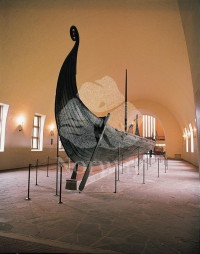
The Times (16.02.04) reports about a found of an Viking ship from the 900
century. Swords, shields, gold and silver coins have been in the ship, which the
treasure hunters believe it is a grave for important Viking chieftain. The place
is so far kept secret, and there will be further explorations.
Photo. The Gokstad Ship. The Viking ship
at Bygdøy in Oslo (Norway) - Viking ship museum culture architecture,
photo number 122000-99#236, photographer Johan Berge/NTR (
www.invanor.no)
Stein Morten Lund, 17 February 2004
Additional information
The
Viking
Ship Museum in
England:
Read more about
the discovery and displaying on the Yorkshire Museum & Gardens: www.yorkshiremuseum.org.uk.
Meet the Vikings
at Yorkshire Museum & Gardens: be inspired by the museum's stunning
collections of Viking artefacts. Take the opportunity to handle real Viking
objects, including an array of objects from domestic life. And join our
experienced guides and see some of Europe's greatest finds from the
Anglo-Saxon and Viking era, including the Gilling sword, Ormside bowl and York
Helmet.
The
Yorkshire
Museum is built
on the ancient site of Earlsburgh, believed to have been a base for Viking earls
outside the city walls of Jorvik. Earl Siward, one of the rulers of
Anglo-Scandinavian York, is buried in the nearby St Olave's Church (founded by
Siward in memory of the Norweigan King, Saint Olaf) and it is likely his home
was on the Museum
Gardens
site.
Address:
Yorkshire
Museum &
Gardens, York,
England.
It`s located
next to Lendal Bridge, the main crossing between the York Station and York
Minster. The entrances are on Museum Street and
Marygate.
The Viking Ship Museum (Oslo,
Norway):
One of the most famous Viking ships, the Gokstad ship, was
found in a large burial mound at the Gokstad farm in Sandar, Vestfold in 1880
(Norway). The ship had been built around 890 A.D. and later used in the ship
burial of an important chieftain who died in or around 900 A.D. The dead man, a
powerfully built man in his 60`s, lay in his bed in a timber burial chamber
(displayed in the Tune wing of the Museum). He was buried with his grave
furnishings which consisted of three small boats, a tent, a sledge and riding
equipment.
The preservation conditions in the Gokstad mound were as favourable as at
Oseberg. The mound had been plundered in ancient times, however, and any
valuables of silver and gold which may have been deposited as burial goods, were
removed.
For more
information click on the link: www.norway.com.
Innovation Norway promotes nationwide industrial
development profitable to both the business economy and Norways national
economy, and helps release the potential of different districts and regions by
contributing towards innovation, internationalisation and promotion. For more
information about Norway (click on the link www.invanor.no)
